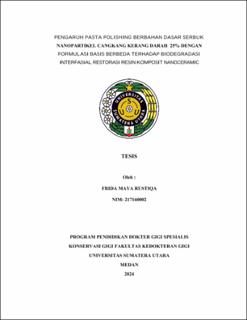Pengaruh Pasta Polishing Berbahan Dasar Serbuk Nanopartikel Cangkang Kerang Darah 25% dengan Formulasi Basis Berbeda terhadap Biodegradasi Interfasial Restorasi Resin Komposit Nanoceramic
The Effect of Polishing Paste Based on 25% Blood Clam Shell Nanoparticle Powder with Different Base Formulations on The Interfacial Biodegradation of Composite Resin Restorations

Date
2024Author
Rustiqa, Frida Maya
Advisor(s)
Yanti, Nevi
Farahanny, Wandania
Metadata
Show full item recordAbstract
Introduction: Biodegradation is a hydrolysis process that occurs in the chemical structure of the tooth and results in the formation of gaps in the margins of the composite resin. Saliva and bacteria are the main components that cause biodegradation. Biodegradation of composite resin can increase the surface roughness of the composite resin, affect the interfacial margin of the composite resin restoration and improve the adhesion of bacteria. This results in an increase in the amount of bacterial biofilm, affecting the long-term success of the restoration. Finishing and polishing play an important role in reducing surface roughness and glossiness of composite resin restorations. Blood clam shell (CKD) (Anadara granosa) polishing paste material has potential as a polishing paste whose main composition contains calcium carbonate. Calcium carbonate is able to become calcium oxide where this compound can be processed into hydroxyapatite which is the main inorganic component in bones and teeth for protection against demineralization processe. The aim of this study was to determine the effect of polishing paste based on 25% blood clam shell nanoparticle powder with carboxy methyl cellulose sodium (CMC-Na) and Carbomer base formulations on interfacial biodegradation.
Material and Methods: The study used 32 samples of maxillary premolar teeth in Class V restorations of nanoceramic composite resin which were divided into 4 groups, namely group A was polished using CMC-CKD paste, group B Carbomer-CKD, group C commercial paste (Prisma Gloss), group D without treatment as a negative control. All samples were soaked in artificial saliva and thermocycling was carried out and followed by cutting the samples. All samples were given exposure to Streptococcus mutans bacteria. Furthermore, each group was stained with SYTO9 and tested using confocal laser scanning microscope (CLSM) to observe interfacial biodegradation. The data obtained were subjected to ANOVA and Post Hoc LSD statistical tests.
Results: The Carbomer-CKD group showed the least interfacial biodegradation in terms of penetration depth and the lowest total bacterial cells of 9.83 m and 2.12 /0.12 mm followed by the CMC-CKD group of 10.63 m and 3.79 /0.1 mm2
Conclusion: The Carbomer-CKD and CMC-CKD polishing groups showed optimal efficacy in inhibiting the penetration of S. mutans bacteria and reducing biofilm formation in the interfacial gap of composite resin restorations.
Collections
- Master Theses [69]
